Services
Hearing Aids
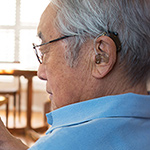 Hearing aids are delicate, carefully-crafted electronic devices that require programming to function properly. With proper care and regular maintenance, your hearing aid should last about 3 to 5 years. This page is to help acquaint you with some of the styles of hearing aids offered at Kaiser Permanente’s Hearing Centers. At your appointment with one of our hearing aid audiologists, they will carefully examine your hearing loss and lifestyle to recommend a style best suited for you.
Hearing aids are delicate, carefully-crafted electronic devices that require programming to function properly. With proper care and regular maintenance, your hearing aid should last about 3 to 5 years. This page is to help acquaint you with some of the styles of hearing aids offered at Kaiser Permanente’s Hearing Centers. At your appointment with one of our hearing aid audiologists, they will carefully examine your hearing loss and lifestyle to recommend a style best suited for you.
One of the most common misconceptions people have when purchasing hearing aids is the assumption that the smaller the hearing aid, the more expensive it will be. Our pricing structure does not charge more for different sizes of hearing aid style. Instead, we choose hearing aid styles (and size) based on our consultation with you and determine which style is needed based on your hearing loss, expectations, and lifestyle. The price of the hearing aid is determined by the sophistication of the computer processor ("chip") that sits inside the hearing aid. The more expensive hearing aids have a more advanced and specific processor to reduce unwanted background noise.
Hearing Aid Types
 IIC (Invisible in the Canal)
IIC (Invisible in the Canal)
IIC aids are the smallest aids that can be chosen. They are custom molded to your ears based on a mold that is taken of your ear canal and the surrounding area. IIC aids are not visible once properly inserted in the ear. They are the smallest hearing aid that can be chosen for the ear and must have an ear canal large enough to accommodate the parts. Due to its small size, there is one microphone on the hearing aid and accommodates milder degrees of hearing loss.
 CIC (Completely in the Canal)
CIC (Completely in the Canal)
CIC aids are one of the smallest hearing aids that can be chosen. They are custom made for you and are barely visible once placed in the ear canal. They have one microphone due to their smaller size. CIC aids are recommended for people who have a mild to moderately severe hearing loss and an ear canal large enough to accommodate the device.
 ITE (In the Ear)
ITE (In the Ear)
ITE aids are larger than completely in the canal aids and can be used for a wider range of hearing loss. They are also available with more features, such as a telephone switch. All of the components fit inside of the plastic case which is made to fit the user's ear. ITE aids can either fill up half of the ear bowl (half shell) or the whole ear bowl (full shell). ITE aids are suitable for people who have a mild to moderately-severe hearing loss.
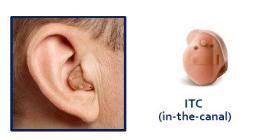 ITC (In the Canal)
ITC (In the Canal)
The ITC hearing aid is also custom molded to the ear and is larger than the CIC hearing aid which accommodates more controls on the device for the hearing aid user to manipulate. Many times, a volume control wheel and/or push button are added controls that are available on this style of hearing aid to give the user more control of the way the hearing aid sounds. Due to its larger size, the battery is larger which lasts days longer than smaller hearing aids.
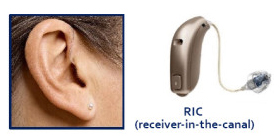 RIC (Receiver in the Canal)
RIC (Receiver in the Canal)
RIC hearing aids have quickly grown to be the most commonly fit hearing device. The two microphones and battery sit in the piece that is housed behind the ear and sound travels down the wire to the speaker (receiver) that sits in the ear canal. Battery life on RIC hearing aids are similar to ITC devices. This style of hearing aid offers natural sound quality and manual controls for the hearing aid user to adjust. Almost all types and degrees of hearing loss can be fit with a RIC device with custom or standard earmold piece.
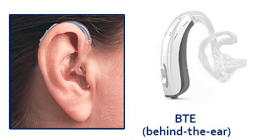 BTE (Behind the Ear)
BTE (Behind the Ear)
There are two components in the BTE aid: a hearing aid and an earmold. The earmold is connected to the hearing aid through a tube. The earmold itself sits in the ear bowl and the hearing aid sits over the ear. The hearing aid amplifies the sound and delivers it to the ear through the earmold. BTE hearing aids are often recommended for children and people with certain middle ear conditions or severe to profound hearing loss. However, with an "open fit" BTE option, the solid earmold is usually replaced with a small ear-tip to amplify the high frequencies without plugging up the ear canal.
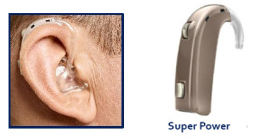 Super Power
Super Power
This largest style of hearing aid is ideal for severe to profound hearing loss and attaches to an ear piece called an earmold. This style is also used for children and comes in a variety of colors. There are manual controls that are larger and easier to use on this device. Reliability of the electronics is high on this type of device due to all of the electronics being housed behind the ear and the battery life is the longest of all hearing aid styles.